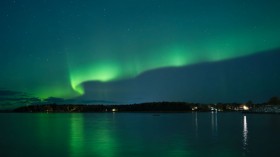Researchers have found evidence that ash from forest fires in the Northern Hemisphere is finding its way into snow-build across Greenland, causing vulnerability and melt of the Greenland ice sheet - which scientists once thought was caused by global climate change alone.
The ice sheet is the second largest body of ice in the world, covering an estimated 660,000 square miles - 80 percent of the surface of Greenland. Past assessments of climate change have estimated that the melt of this sheet will be a significant contributor to rising sea levels. In fact, a recent study of the massive island's costal glaciers revealed that they may reach an estimated 65 miles inland underneath Greenland's bedrock. In the event of their melt, the world's sea levels will rise significantly higher than previous studies have estimated.
Still, even with an increasing understanding of the Greenland melt, researchers still don't know exactly how fast it will happen, as the causes remain somewhat unclear.
Now, a study published in the Proceedings of the National Academy of Sciences details how Dartmouth researchers, in collaboration with the Thayer School of Engineering and the Desert Research Institute, found that both a warming climate and ash buildup are contributing to the ice sheet's melting.
"The widespread melting of the Greenland ice sheet required the combination of both of these effects - a lowered snow albedo from ash and unusually warm temperatures - to push the ice sheet over the threshold," Kaitlin Keegan, the study's lead author, said in a Dartmouth press release.
According to Keegan, because of its natural white sheen, snow can resist sunlight, reflecting beams away to resist inevitable melt. This reflective property is called snow "albedo." However, when dark ash blown in from massive forest fires occurring in the Northern Hemisphere mixes with the snow, Greenland's snowpack and ice begins to lose its luster - becoming more vulnerable to the Sun.
In an assessment of the ice sheet's history from 1889 to 2012, Keegan and her team found increasing ash particulate counts in the snow every few years. This makes sense, as a historical analysis revealed that instances of forest fires in the Northern Hemisphere have been on the rise recently, rivaling those that went unchecked the late 1800s.
Still, it is important to note that while ash is seen as an influential factor separate from climate change, some experts will claim that an increasing prevalence of forest fires is a direct result from an increasingly warm and dry climate in the Northern Hemisphere.
The study was accepted for early release by the Proceedings of the National Academy.
© 2024 NatureWorldNews.com All rights reserved. Do not reproduce without permission.





